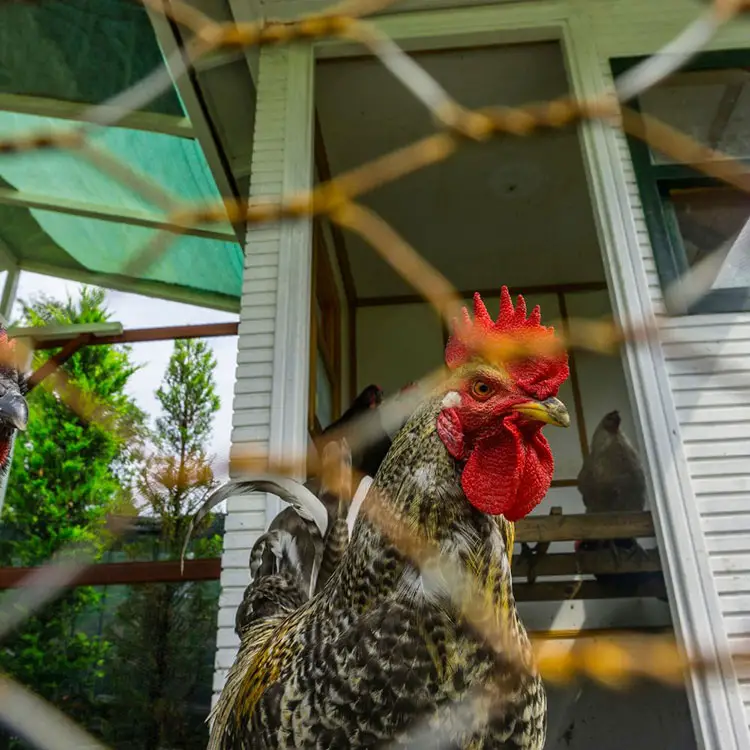Raising hens for meat or eggs on a farm is a very difficult job, but it can also be tremendously gratifying. To maintain harmony in the flock and make sure that everyone is living contentedly and thriving, various breeds of chickens and the number of hens and roosters in the coop have varied demands, which must all be satisfied. Making sure each chicken has adequate room to roam about is one method to keep the flock happy and healthy, but depending on the size of your flock, this may be a difficult chore to do.
If you’ve never raised hens before, you probably have questions about the ideal size for the coop and the outside space where the birds spend their days. When beginning a chicken farm and purchasing your first flock of hens, all of these factors should be taken into account beforehand.
Even seasoned farmers have had trouble determining the ideal size for a chicken coop when the flock is too large and not every hen or rooster has enough room. Observing that your hens are becoming ill more often is another sign that you need a larger coop.
Due to their small living quarters, hens are more likely to infect one another with parasites and other pathogens, which makes them more susceptible to illness. Finally, keeping them in a smaller coop may have behavioral repercussions, such as having two or more roosters that will fight more often.

It is crucial for every coop to have adequate room for the hens, but how much area do they really need? The amount of room hens need for laying eggs, resting in the coop, and free-roaming will all be covered in this article.
If you follow the instructions in the preceding paragraphs, you will undoubtedly construct a roomy coop that will satisfy the requirements of your hen flock and ensure their wellbeing. Continue reading!
Why Do Chickens Need Their Space?
Individual hens won’t need a lot of room to go around and spend their days, whether you’re just thinking about the size of the outdoor space or the coop. But hens also need “me” time, when they may be unrestricted and at ease, and this is crucial for both their reproductive systems and general well-being.
A henhouse with its own area guarantees that the birds will lay eggs without difficulty, be content and flourish, and stay out of the way of roosters and cockerels that are extremely protective of their territory. The reasons why a chicken’s attitude and stress level are impacted by their general living area are listed below.
Chickens value their space because:
It reduces their stress levels: Despite being very gregarious creatures, chickens nevertheless need privacy, particularly while they are fertilizing their eggs. They will feel calmer and less anxious and be more productive when they are not crowded by other hens too closely.
Lessens fights: Crowding has an impact on hens’ moods and increases their likelihood of fighting. Bullying, feather plucking, and even eating their own eggs are common behaviors among chickens.
It enhances their health: As was previously noted, crowded and closely spaced hens might facilitate the spread of parasites between them. Several hens may avoid contracting diseases from germs and parasites if they have enough room.
Cleaning is made simpler since there is more room for the excrement to be dispersed around the coop, making cleaning easier.
How Much Room Is Needed for Chickens?
Even though they won’t need a large amount of space, hens still need to have enough room to live in order to be active and content both inside and outside the coop. You’ll notice that when they have adequate room to live, they are the happiest.
It makes sense that you won’t always be able to afford or construct an incredibly huge chicken coop, but in such situations, you should choose to have fewer hens. A smaller flock of happy, well-produced eggs and meat is preferable to one that is overcrowded and causes suffering for all of the hens.
Some basic guidelines must be followed in order to provide the hens proper care. You won’t have to build them a castle, but you can still provide them a decent living without going over budget or giving up too much land on your farm.
It’s important to keep in mind that hens will spend most of their time outside, preferably in a fenced area large enough to let them walk about freely. You should read through to the finish since, even though they spend less time in the coop itself, it’s crucial to emphasize the recommendations for both the coop and outside enclosure.
Cooperation Area
The bulk of a chicken’s life will not be spent within their coop. Except during the evenings and the winter, they will spend most of their time running about the cage. Nevertheless, they may take use of the bigger outside areas while still having a respectable amount of inside space to feel cozy and happy.
Recall that some chickens are bigger than others, meaning that certain birds will need more room than others. It may take up to two feet per bird for smaller chickens. bigger hens, on the other hand, will need a bigger coop—roughly three square feet for each bird.
The biggest hens, like Plymouth Rock, need a coop that is four to five square feet in size. You can determine the ideal coop size for your hens by quickly calculating the amount of space needed for each bird. You have two options: estimate the size or figure out how big the coop has to be in relation to 10, 20, or the number of hens you want to house in it.
You will also need to take the weather into account. You will need to take into account that the hens will spend more time indoors if you reside somewhere with frigid winters. Having said that, you will want a few more square feet for each bird.
For the purpose of having enough room to lounge, smaller chickens need around 5 to 6 square feet, medium-sized birds up to 8 square feet, and biggest chickens up to 10 square feet.
Use our Chicken Coop Size calculator and enter all the criteria you can think of if you’re still not sure. You’ll be able to determine just how much room your hens want in this manner.
Outside Area
Your hens will spend their nights in the coop and their days on the outdoor runs within the enclosure throughout the spring, summer, and even autumn. For hens, playing outdoors and soaking up the sun’s rays is good. Even yet, each chicken needs its own place, particularly if you have many roosters. You want to make sure that none of them become hostile.
Chicks will only spend the night in a large coop, so if you live in a climate where the weather is always warm, you should concentrate on building an outdoor enclosure instead. Every chicken will need at least 10 to 12 square feet of room, so keep that in mind while constructing the outside enclosure.
But it’s important to note that if you can give them more room, hens will appreciate it much more. In this manner, the hens will stay out of each other’s way, respect each other’s space, and refrain from bothering them until they feel like talking.
Roosting Bars
Any hen flock should include a few Roosting Bars, therefore you should think about constructing or purchasing one for your flock. Elevated bars in the coop where hens sleep are known as “rooting bars.” The higher they are, the better, as jumping on them is a crucial component of the survival instinct of chickens. They needed to go higher in order to live.
The fact that this behavior has persisted even after domestication only serves to highlight how crucial it is that you create an adequate area for roosting. For roosting, each chicken needs at least 7 to 12 inches of space. Not to mention that since your chicken will lay eggs and raise chicks in them, you should have nesting boxes.
Things to Take Into Account When Selecting a Chicken’s Living Space
Building a living space for your chickens should take into account a few other things in addition to making sure they have enough room. Continue reading to learn more.
Airflow
It shouldn’t be too difficult to ventilate a large coop that you’re building. Nevertheless, you will need to make sure the coop has a windbreak or some sort of ventilation. Because they can be messy creatures, hens may become uncomfortable with the smell of their coop if you don’t clean it on a regular basis.
That being said, a report states that it is crucial to make sure the hens in the coop have enough ventilation. If there isn’t enough fresh air for them to live comfortably, then not even having enough space will help.
Nesting Containers
There will almost always be a hen laying eggs every day, depending on how many chickens you have. Your hens will probably lay more frequently if you have more of them. Regardless of the situation, you must give your hens enough room.
Every third or fourth hen in your flock needs a nesting box if you have more than five hens. In this manner, each of the three to four hens will have a nesting box. You won’t have to worry about egg production in this way.
Ample Food and Watering Resources
You must provide your hens adequate food and water if you have a large flock. Additionally, you must respect their personal space by giving them dishes filled with food and water that are appropriate for the number of chickens you have and their needs.
This is particularly crucial if you feed treats to your chickens. It’s crucial to divide the treats equally among the chickens and make sure they have enough for each one to avoid conflicts and territorial encroachment.
Defense
When building a chicken coop, one of the most crucial factors to take into account is making sure the space is big enough for all the chickens to sit in comfort and out of the way of outdoor predators like wolves, coyotes, and foxes. If there is not enough room for every chicken to have their unique needs met, the chickens will go elsewhere for comfort, leaving them more exposed and vulnerable to a predator’s attack.
Characteristics
Remember that the temperament of the chickens is another important factor to take into account when deciding on the size of the chicken coop. Hens can be assertive and occasionally hyperactive, but roosters can be quite territorial and aggressive.
It is crucial to keep the roosters apart and give each chicken in the coop enough room in order to avoid bullying and even territorial fights. Feathers flying all over the place is not what you want to see.
The Drawbacks of Big Chicken Coops
Being able to have a large chicken coop is generally not seen as a drawback. A smaller flock inside a larger chicken coop is always preferable to a larger flock inside a smaller chicken coop.
Nevertheless, it’s important to note that cleaning the coop will take longer than it would if it were smaller. That still implies, though, that the hens will have more room and won’t be suffocated by ammonia. However, if you want to use deep littering techniques to keep chickens warm throughout the winter, you can compost their waste.
Though the above-mentioned method is a great way to keep the chickens warm, the larger coop will get colder in the winter, so you’ll need to invest in some heating techniques.
Farmers will still, however, much rather give their hens more room than confine them to small quarters.






